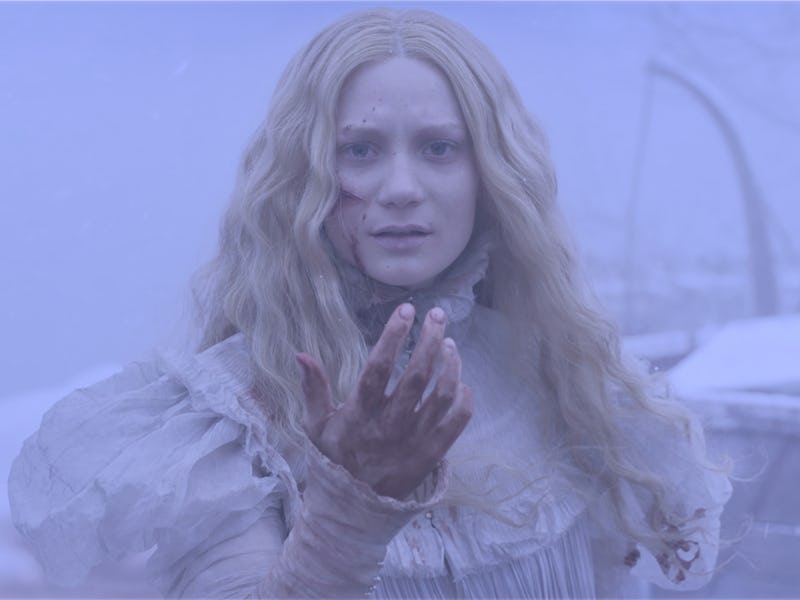'Crimson Peak' Is Jane Austen Served Bloody
Guillermo del Toro's latest is elegant, gothic, and brutal. Yet, surprisingly, not a horror film.

Guillermo del Toro is not the kind of filmmaker who can be counted on to produce variations on the same formula. He flits from dark whimsy like Pan’s Labyrinth to futuristic robot dystopia like Pacific Rim, making each film a unique, self-contained world. As del Toro’s favorite costume designer Kate Hawley said when I spoke to her, he initially told her his new film Crimson Peak was “just Victorian,” but with del Toro, “nothing is ever just anything.”
Unfortunately, whoever is advertising Crimson Peak must not have gotten that memo, because its posters and trailers are misleading in their emphasis on its horror. While it certainly strays into that realm, it isn’t a horror movie. Crimson Peak is as ambitious as del Toro’s previous effort, Pacific Rim, in a different way. Rather than building a futuristic robot world, Crimson Peak is del Toro’s attempt to stitch together characters, archetypes, and motifs from 19th century British and gothic literature and synthesize them into a coherent visual narrative. In other words, he made a robot film and now he’s making a book film. Not just a book but many books, old books, with crackling yellowed pages and cobwebs draping the shelves they sit on.
Translating many disparate works of literature onto the screen isn’t easy (most book-to-screen adaptations borrow from one specific book) but for the most part, del Toro succeeds. The lead, Edith — played by Mia Wasikowska, who not-so-coincidentally also played Jane Eyre in Cary Fukunaga’s adaptation — is part Jane Eyre, part Mina Harker, and part Elizabeth Bennet. Her brooding Byronic love interest, Sir Thomas Sharpe (Tom Hiddleston) is stitched from the same cloth as Mr. Rochester, Maxim de Winter, Mr. Darcy, and Edgar Ravenswood.
In the first half of the film, the dynamic between Edith, Sir Thomas Sharpe, and her childhood friend Dr. Alan McMichael (Charlie Hunnam) is in line with the conventions in these types of narratives: as Austen says, a single woman in possession of questionable fortune must be in want of a husband — but should she aim for safety and practicality with the nice yet boring doctor, or follow her heart on an uncertain path with the mysterious stranger?
This isn’t a spoiler to say we all know who she picks, but there are echoes of Pride and Prejudice, as Edith’s relationship with Thomas begins with judgements and misunderstandings and dances. And just like Darcy’s Pemberley or Maxim de Winters’ Manderley, Thomas Sharpe has a sprawling estate called Allerdale where, to put it in fancy 19th century diction, shit goes down.
The film is a thrill for literary geeks; watching it is a kind of a “spot the reference!” game. But in the second half, the references shift from Jane Eyre and Pride and Prejudice to Dracula and Sherlock Holmes. (If this doesn’t make your head hurt too much, Sherlock star Benedict Cumberbatch was originally cast as Sir Thomas Sharpe, but he left to star in another movie that he’s no longer starring in but Charlie Hunnam — who plays Crimson Peak’s resident amateur detective —is). There are even visual echoes of The Silence of The Lambs, the fairytale Bluebeard that even Disney didn’t want to try and sanitize, and Poe’s The Fall of the House of Usher. The gloriously loony, should-be-condemned estate of Allerdale is an Abandoned-Porn wet dream.
The melting pot of narratives works nicely for the visuals, but it’s here that the story stumbles in the form of characterization. Thomas’s sister Lucille (Jessica Chastain) is straight out of Rebecca, with equal parts Mrs. Danvers and Rebecca — but we don’t have the same level of back story and it doesn’t quite add up. We’re left wanting more from her, especially because Chastain’s performance is so magnetic.
And in the second half, Charlie Hunnam’s Dr. Alan McMichael transforms from his square “guy who doesn’t get the girl” archetype into a combination of Sherlock Holmes, Dracula’s doctor John Seward and the American cowboy Quincey Morris, with a hint of Van Helsing and a dash of Jonathan Harker. Basically every male character in Dracula aside from Dracula, and also Valancourt from The Mysteries of Udolpho. If you think that sounds like too many different archetypes to work, you’re right. It makes you wonder if del Toro blew his budget on the set, didn’t have enough money for more actors, so told Charlie Hunnam, “It’s fine, I’ll just have you play nine different characters!”
At the beginning, Dr. McMichael seems boring and we don’t question why Edith choses Thomas Sharpe. But unlike his literary “guy who doesn’t get the girl” predecessors, the more we learn of him, the more we say, “um … so tell me again, why didn’t Edith pick him?!” Because then there would be no plot, that’s why.
Trying to cover all the gothic archetype bases makes for uneven characterization. But other than that, the film unfolds with a strong sense of dread peppered with del Toro’s signature elegant monsters. It’s equal parts homage to the gothic genre and a new entry with some Game of Thrones-style carnage for today. It’s no easy task, to spin several works of 19th century lit into a tense, coherent film in our current age of yawning at the apocalypse. With great ambition comes a capacity for failure, and although Crimson Peak does not succeed on every level, it’s gorgeously wrought and elegant with a sprinkling of brutality and a magnetic performance from Jessica Chastain. But don’t expect it to be just a horror movie.
Crimson Peak hits theaters on Friday.